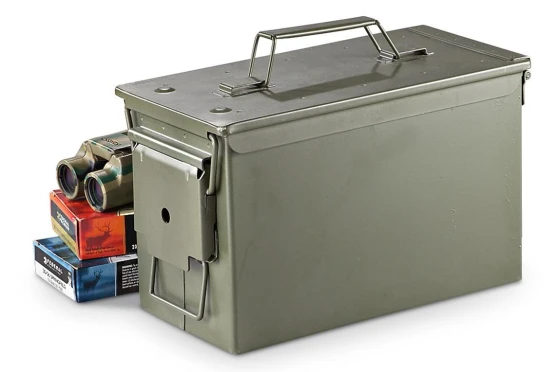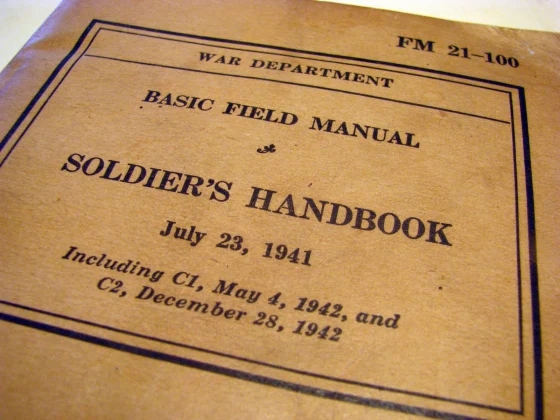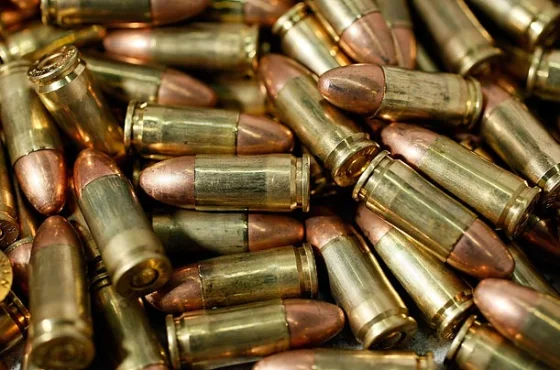Spoiler:
Recently a friend acquired a gently used replica of the Colt M4 rifle in .22LR caliber that is manufactured under license by Walther Firearms. I have seen them advertised in shooting magazines, but until now I had never actually seen or held one. The are sold by Colt and sport the “embattled horse” Colt logo on the lower receiver, and other than the 30-round single-stack magazine being slightly longer than the 30-round magazine of a real AR type rifle, they are pretty much a perfect one-for-one visual replica of the real thing.
Remington Golden Bullets did not function at all in the rifle that I tested. Federal 550-round bulk pack ammunition operated flawlessly.
Read the instructions and watch the video included farther down before you attempt to disassemble the rifle. It does not disassembly anything like a real AR15. Do not attempt to disassemble the bolt hold-open assembly. It is very difficult to reassemble and easy to clean without taking it apart.
Zero the rifle at 25 yards. From approximately 13 yards to 89 yards you can expect your round to hit +/- 1″ from your point-of-aim. At 100 yards you can expect your round to impact approximately 2″ to 2.5″ below your aiming point.
If you don’t have the patience for a detailed explanation, then you will still be well served by the information above. If you want to know more, keep reading.
Contents:
- Introduction
- Features and Observations
- Reliability
- Accuracy
- How To Disassemble and Clean Walther’s Colt M-4 .22LR Carbine
- What Distance You Should Zero Your .22LR AR-15
- Conclusion
Introduction:
Recently a friend acquired a gently used replica of the Colt M4 rifle in .22LR caliber that is manufactured under license by Walther Firearms. I have seen them advertised in shooting magazines, but until now I had never actually seen or held one. The are sold by Colt and sport the “embattled horse” Colt logo on the lower receiver, and other than the 30-round single-stack magazine being slightly longer than the 30-round magazine of a real AR type rifle, they are pretty much a perfect one-for-one visual replica of the real thing.
From Walther’s website: “The Colt M4 Carbine is a spot on .22 LR replica of the current carbine version of the M-16 machine gun issued to U.S. military. It features a carbine length barrel, collapsible stock and removable carry handle. As with the original, the upper and lower receiver is made of high quality aluminum. The Colt M4 Carbine Semi-Automatic Rifle in .22 L.R. is manufactured exclusively by Walther under license from Colt. It is the only genuine Colt tactical rimfire replica available in the world.”
At first I thought that the rifle might simply be a Colt AR-15 lower receiver paired with a dedicated .22LR upper receiver assembly. This is not the case. The actual firearm mechanism fits snugly inside a M4 façade and does not function anything like a real M4 / AR-15 / M-16 type of firearm. In fact, the M4 style barrel with grenade launcher cutout is simply a sleeve that the actual .22LR barrel fits into. While this sound cheap, the rifle actually feels solidly constructed.
back to top
Features and Observations:
The bolt release is a dummy and does not have any function other than to help make the rifle look authentic.
The forward assist is also a dummy and does not have any function.
The rifle bolt locks to the rear when the last round in the magazine is fired. To release the bolt, eject the empty magazine, load a new magazine, and run the charging handle. The bolt should drop and load a fresh round into the chamber.
The 30-round single stack magazine is longer than a 30-round 5.56mm NATO magazine that it is intending to replicate. They may or may not fit into your magazine pouches. If you can fit a 40-round 5.56mm NATO magazine, then you should be good to go. The magazines do not have metal lips, so I can’t say for sure how long they will last. Buy a few extra.
The particular rifle model is called the “M4 OPS”. It has a railed forend which is not “drop-in” and appears to only be connected to the firearm where the barrel nut is on a real AR-15. The barrel is essentially free-floating as the railed forend doesn’t seem to have any contact points with the barrel. The rifle comes with four of what appear to be Knight’s Armament Corporation brand rail covers, minus the KAC logo. Are they knockoffs? I can’t tell. They serve their purpose on the .22LR rifle, though.
The rear sight is looks just like a real A-2 rear sight. It has dual apertures; on a real AR-15 / M-4 / M-16 the larger for shooting 0-200 meters, and the smaller for shooting longer distances. This feature can serve nothing more than to preserve the authentic AR-15 look since most .22LR bullets drop below supersonic speed around 50 yards, and will have bled off most of their effective squirrel / rabbit killing energy around 100 yards. You won’t be hitting many intended targets past 100 to 150 yards. While the sights seem perfect for a training rifle or “fun gun”, I’m not sure that I would trust it to run on a real 5.56mm NATO battle rifle. I noticed that when you flip between the large and small apertures that it occasionally rotates the windage knob, which will move point-of-impact. Your best bet will be to select which aperture that you prefer to shoot with, adjust the sights for your preferred zero (see below), and then leave the sights alone and don’t ever touch them again. You should be good to go. If you are really paranoid, you can replace them with a higher quality model, but if you can trust your kids not to flip the apertures, then you should be good with the sights that came with the rifle. Just like any removable item on a firearm (optic, light, etc.) be sure to use a dot or two of Loctite thread locker on the mounting screw threads. The rifle’s owner stated that they had trouble with the rifles sights staying zeroed. Upon examination I discovered that the rear sight’s mounting screw had indeed worked itself loose and the rear sight assembly was loose enough to wiggle around on the rail. Easy fix.
On initial examination of the rifle I thought that it might be a good candidate to receive a .22LR suppressor that would stay on the rifle all of the time. After reading the disassembly directions and watching the videos below, I realized that (spoiler alert!) the rifle’s flash-hider is a key component that holds the rifle together (I’m serious… watch the videos), so mounting a suppressor on this particular .22LR AR-15 is not an option (disappointment). Needless to say, you are stuck with the traditional looking A-2 birdcage flash-hider, and a real one with the industry standard 1/2 x 28 threads will not fit.
back to top
Reliability:
Prior to testing, the rifle was thoroughly cleaned, wiped dry of excess cleaning oil, and then all of the moving parts were lubricated with a very thin film of Lithium grease. I used both magazines that were supplied with the rifle, taking note of how many, if any, malfunctions occurred in which magazine, just in case the magazine was the culprit.
As has been discussed in other sections of Savannah Arsenal, rimfire firearms can be very finicky about what brand of ammunition they prefer. Some guns will run great on a certain brand, while they fail miserably with another. The only way to be sure what your gun will shoot is to try several brands.  Don’t get frustrated if it doesn’t function with a particular brand. Just try another until you find what works, and then stock up on that brand when ever it is available.
Don’t get frustrated if it doesn’t function with a particular brand. Just try another until you find what works, and then stock up on that brand when ever it is available.
I only had two types of ammunition to test: Remington’s bulk pack 36-grain hollow-point “Golden Bullets” (seen right, top), and Federal’s bulk-pack 36-grain copper washed hollow-points (seen right, bottom).
I first tried a full 30-round magazine loaded with Remington Golden Bullets. Golden Bullets are the manufacturer’s recommended ammunition for the Advantage Arms .22LR conversion kits made for Glock pistols and run great in those guns. They also work great in my two Ruger 10/22 rifles. In the Colt M4 .22LR rifle, however, I could not get a single Remington to successfully feed into the chamber. They would get hung up, not enter the chamber, and jam the gun. I tried downloading the magazine down to 15 rounds to see with less tension of the magazine spring if the gun would function. It didn’t. I also tried the same with the second magazine without any luck. In this particular firearm the Remington ammunition failed miserably. I immediately had a bad feeling that this type of firearm was a bad design, or that at least this individual gun was a lemon.
I fully loaded both magazines with Federal’s hollow-points. They fed and functioned perfectly. I ran seven full magazines loads, for a total of just over 200 rounds, without a single malfunction.
In this gun the Remington ammunition was worthless, while the Federal ammunition ran great. Keep in mind that your results may vary with your individual firearm, but expect good results from the Federal. You should still try a sampling of a couple of hundred rounds of several types of ammunition so that you can truly depend of your firearm.
back to top
Accuracy:
I was only able to test the rifle at a 25 yard, indoor range. I did not have a proper shooting table to beanbag rest the rifle, but I was able to place a large beanbag on the shooting stall’s reloading shelf and shoot with the rifle’s magazine resting on the beanbag. While this wasn’t the perfect testing environment, it was more stable than I had expected to have in a standup, indoor range.
The rifle will eventually sport a Bushnell TRS-25 red-dot optic co-witnessed with the iron sights using UTG’s Medium Profile Riser Mount, but for this test I only had the factory iron sights.
I zeroed the rifle at 25 yards (see “What Distance You Should You Zero Your .22LR AR-15” farther down this page). I was able to carefully shoot sub golf ball size groups with the rifle crudely rested as described above, and easily shoot baseball size groups off-hand. The accuracy test results, when considering the combination of bulk ammunition and the less than perfect testing environment, were totally acceptable. You should expect even better results with quality ammunition and a decent bench rest shooting position.
For rimfire training and plinking this rifle’s accuracy is perfectly acceptable. I’ll expect even better results after the red-dot is mounted and zeroed. I may try CCI’s Mini-Mag ammo for accuracy and reliability. I’ll update the results as soon possible.
back to top
How To Disassemble The Colt M4 .22LR Carbine:
Fieldstrip:
According to the rifle’s manual, you are only supposed to break down the rifle into its basic upper and lower components, spray them out with Gun Scrubber, and put a drop of oil in a few key locations.
Full Disassembly:
The manual also states that any further disassembly will void Walther’s excellent warranty. The problem is that .22 ammo is very dirty to shoot, and to properly clean and lubricate the rifle, further disassembly is absolutely necessary. You may choose to follow the manufacture’s cleaning and lubrication recommendations, but if you start to suffer serious reliability issues, you may choose to go ahead and break the rifle down further.
Do not attempt to disassemble the rifle until you have thoroughly studied the rifle’s downloadable instruction manual and watched the disassembly videos farther down on this page. The rifle looks like an AR, but looks are where the similarities end. It doesn’t disassemble anything like an AR, so all of your vast AR expertise is wasted with this rifle. Note that there are several small springs and pins that are under pressure when assembled. Do not attempt to disassemble the rifle if you are standing on a shag carpet. If you launch a spring then you will never see it again. If you are mechanically inclined then you should be able to watch the disassembly videos below and read the owner’s manual and be able to figure it out.
The biggest disassembly / assembly “pain in the ass” appears to be reinstalling the tiny spring and pin that offer resistance to the bolt hold open mechanism. The videos below are very vague with how to take the mechanism apart or how to put it back together. It is really easy to drop the parts, they are easily damaged during installation, and if the spring and pin are missing then the bolt hold open is free to flop down and lock the bolt down at any time. The previous owner had not properly assembled the rifle. The spring was missing and so the bolt hold open mechanism flopped up and down without the tension to normally hold it into place until the empty magazine’s follower could force it into position to lock the bolt open. It would occasionally lock the bolt back even though the magazine wasn’t empty. I simply removed the bolt hold open parts and the rifle ran perfectly without them, except that the bolt didn’t lock back after the last round was fired. I didn’t miss this feature as it isn’t even a requirement of a NATO approved battle rifle. (How many rifles can you think of that lock open after the last round? Not many.)
Recommendations:
Watch the videos before you attempt to disassemble the rifle.
When you disassemble the rifle, do not disassemble the bolt hold open mechanism. It is easy to clean around it while it is in place. You will save yourself a huge headache. If you don’t heed my warning, replacement parts can be ordered on from the phone number found on the last page of the instruction manual.
I don’t see any reason to disassemble the trigger mechanism. It looks like a complete pain in the ass. If it is dirty, spray it out with Gun Scrubber, put a few drops of oil as recommended, and you will be good to go. If you are planning to store the rifle for an extended period of time, you can shoot some Break Free or other aerosol gun lubricant into the mechanism, and use an air compressor to blow the excess oil out of the receiver.
I had a lot of luck with placing a couple of drops of gun oil on the trigger mechanism within the lower receiver, and then I placed a thin film of lithium grease anywhere that the bolt has contact within the upper receiver where it travels backwards and forwards.
back to top
What Distance You Should You Zero Your .22LR AR-15:
I have done a couple of articles on what distance is the best all-purpose zero for a particular rifle / caliber combination. I have never really taken dedicated .22LR AR-15 rifles seriously until I was asked to help zero this rifle. Why even bother? Why would I waste my time with a rifle firing .22LR ammo with sights that are 2.5″ above bore? Any traditional .22LR rifle has its sights mounted close to the bore, and traditionally red-dots are always mounted as close to the bore as possible. I couldn’t see how you could have anything but a terrible .22LR ballistic trajectory with AR-15 sights that are 2.5″ above the bore.
Having been granted the opportunity to play with this rifle for a few days I ran a few zero distances through my ballistics app on my iPad using data for CCI’s 36-grain Mini-Mag ammunition, and I couldn’t believe how ignorant I had been. I played with several distances and tweaked it until I found the optimum zero distance of 25 yards.
Benefits of a 25 Yard Zero:
- Note the graph above. From a distance of 13 yards from the muzzle, all the way out to approximately 89 yard, the point-of-impact of the bullet will never be +/- 1″ from point-of-aim. This means that you should be able to hit a 2″ target without any hold-over / hold-under correction anywhere within 13 yards to 89 yards!
- The highest distance above point of aim is exactly 1″ at 50 yards.
- At 100 yards you can expect your point-of-impact to be 2.37″ below your point-of-aim. To give you a visual, you will make hits below the point-of-aim less than the height that the sights set above the bore. This is pretty impressive, especially considering that you might be using a red-dot optic, such as the Bushnell TRS-25, with a 3 minute-of-angle dot (dot that appears 3″ in diameter at 100 yards). If the dot touches the target, you should be able to hit within that dot out to 100 yards.
back to top
Conclusion:
Based on my experience, here is how I graded it:
- Fit & Finish: “A-“. Looks great, but it still isn’t a real AR. The rear sight assembly isn’t very high quality.
- Practical Accuracy: “A-“. I’ll probably change it to an “A” or “A+” when I get to shoot it with a red-dot optic and better ammunition.
- Ballistics: “A”. A ballistic trajectory with the rifle’s AR style sights sitting 2.5″ over bore, coupled with a 25 yard zero, give the rifle a very flat trajectory out to 100 yards.
- Ease of Maintenance: “D”. This gun isn’t easy to take apart and reassemble for proper cleaning. It gets a “B” if you are willing to settle for a Gun Scrubber spray cleaning in the field.
- Reliability: “A” with the right ammo. “F” is you try to run the wrong ammunition.
This looks like good rifle for training and plinking. Equip it with a red-dot optic and some type of inexpensive tactical light mounted to the rail system and you will have yourself a serious tactical squirrel killer.


































